Moors
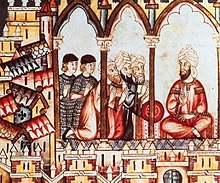
The term Moor is an
The term has also been used in Europe in a broader sense to refer to Muslims in general,
In 711, troops mostly formed by Moors from northern Africa led the
Name
Etymology
The etymology of the word "Moor" is uncertain, although it can be traced back to the Phoenician term Mahurin, meaning "Westerners". From Mahurin, the ancient Greeks derive Mauro, from which Latin derives Mauri.[10] The word "Moor" is presumably of Phoenician origin.[11] Some sources attribute a Hebrew origin to the word.[12]
During the classical period, the
During the Latin Middle Ages, Mauri was used to refer to Berbers and Arabs in the coastal regions of Northwest Africa.
Modern meanings
In medieval
Apart from these historic associations and context, Moor and Moorish designate a specific ethnic group speaking Hassaniya Arabic. They inhabit Mauritania and parts of Algeria, Western Sahara, Tunisia, Morocco, Niger, and Mali. In Niger and Mali, these peoples are also known as the Azawagh Arabs, after the Azawagh region of the Sahara.[19]
The
In the
Moreno can mean "dark-skinned" in Spain, Portugal, Brazil, and the Philippines. Also in Spanish, morapio is a humorous name for "wine", especially that which has not been "baptized" or mixed with water, i.e., pure unadulterated wine. Among Spanish speakers, moro came to have a broader meaning, applied to both Filipino Moros from Mindanao, and the moriscos of Granada. Moro refers to all things dark, as in "Moor", moreno, etc. It was also used as a nickname; for instance, the Milanese Duke Ludovico Sforza was called Il Moro because of his dark complexion.[26]
In Portugal, mouro (feminine, moura) may refer to supernatural beings known as enchanted moura, where "Moor" implies "alien" and "non-Christian". These beings were siren-like fairies with golden or reddish hair and a fair face. They were believed to have magical properties.[27] From this root, the name moor is applied to unbaptized children, meaning not Christian.[28][29] In Basque, mairu means moor and also refers to a mythical people.[30]
Muslims located in South Asia were distinguished by the Portuguese historians into two groups: Mouros da Terra ("Moors of the Land") and the Mouros da Arabia/Mouros de Meca ("Moors from Arabia/Mecca" or "Paradesi Muslims").[31][32] The Mouros da Terra were either descendants of any native convert (mostly from any of the former lower or untouchable castes) to Islam or descendants of a marriage alliance between a Middle Eastern individual and an Indian woman.
Within the context of Portuguese colonization, in Sri Lanka (Portuguese Ceylon), Muslims of Arab origin are called Ceylon Moors, not to be confused with "Indian Moors" of Sri Lanka (see Sri Lankan Moors). Sri Lankan Moors (a combination of "Ceylon Moors" and "Indian Moors") make up 12% of the population. The Ceylon Moors (unlike the Indian Moors) are descendants of Arab traders who settled there in the mid-6th century. When the Portuguese arrived in the early 16th century, they labelled all the Muslims in the island as Moors as they saw some of them resembling the Moors in North Africa. The Sri Lankan government continues to identify the Muslims in Sri Lanka as "Sri Lankan Moors", sub-categorised into "Ceylon Moors" and "Indian Moors".[33]
The
Moors of the Maghreb
In the late 7th and early 8th centuries CE, the Islamic Umayyad Caliphate, established after the death of Muhammad, underwent a period of rapid growth. In 647 CE, 40,000 Arabs forced the Byzantine governor of northern Africa to submit and pay tribute, but failed to permanently occupy the region.[34] After an interlude, during which the Muslims fought a civil war, the invasions resumed in 665, seizing Byzantine North Africa up to Bugia over the course of a series of campaigns, lasting until 689. A Byzantine counterattack largely expelled the Arabs but left the region vulnerable. Intermittent war over the inland provinces of North Africa continued for the next two decades. Further civil war delayed the continuation of further conquest, but an Arab assault took Carthage and held it against a Byzantine counterattack.
Although a Christian and pagan Berber rebellion pushed out the Arabs temporarily, the Romanized urban population preferred the Arabs to the Berbers and welcomed a renewed and final conquest that left northern Africa in Muslim hands by 698. Over the next decades, the Berber and urban populations of northern Africa gradually converted to Islam, although for separate reasons.[35] The Arabic language was also adopted. Initially, the Arabs required only vassalage from the local inhabitants rather than assimilation, a process which took a considerable time.[35] The groups that inhabited the Maghreb following this process became known collectively as Moors. Although a Kharijite rebellion would later push out Umayyad rule from the western Maghreb and form temporarily independent Arab, Berber and Persian dynasties, that effort failed to dislodge the usage of the collective term.
Modern use in parts of the Maghreb
The term has been applied at times to urban and
Moors of Iberia


In 711 the Islamic Arabs and Moors of Berber descent in northern Africa crossed the Strait of Gibraltar onto the Iberian Peninsula, and in a series of raids they conquered Visigothic Christian Hispania.[38] Their general, Tariq ibn Ziyad, brought most of Iberia under Islamic rule in an eight-year campaign. They continued northeast across the Pyrenees Mountains but were defeated by the Franks under Charles Martel at the Battle of Tours in 732.[39]
The Maghreb fell into a civil war in 739 that lasted until 743 known as the Berber Revolt. The Berbers revolted against the Umayyads, putting an end to Eastern dominion over the Maghreb. Despite racial tensions, Arabs and Berbers intermarried frequently. A few years later, the Eastern branch of the Umayyad dynasty was dethroned by the Abbasids and the Umayyad Caliphate overthrown in the Abbasid revolution (746–750). Abd al-Rahman I, who was of Arab-Berber lineage, managed to evade the Abbasids and flee to the Maghreb and then Iberia, where he founded the Emirate of Córdoba and the Andalusian branch of the Umayyad dynasty. The Moors ruled northern Africa and Al-Andalus for several centuries thereafter.[40] Ibn Hazm, the polymath, mentions that many of the Caliphs in the Umayyad Caliphate and the Caliphate of Córdoba were blond and had light eyes.[41] Ibn Hazm mentions that he preferred blondes, and notes that there was much interest in blondes in al-Andalus amongst the rulers and regular Muslims:
All the Caliphs of the Banu Marwan (God have mercy on their souls!), and especially the sons of
al-Nasir and al-Hakam al-Mustansir (may God be pleased with them!), I have been informed by my late father, the vizier, as well as by others, that both of them were blond and blue-eyed. The same is true of Hisham al-Mu'aiyad, Muhammad al-Mahdi, and `Abd al-Rahman al-Murtada (may God be merciful to them all!); I saw them myself many times, and had the honour of being received by them, and I remarked that they all had fair hair and blue eyes.[42]
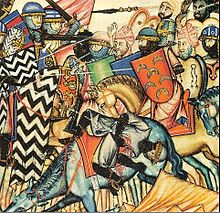
The languages spoken in the parts of the Iberian Peninsula under Muslim rule were
The Caliphate of Córdoba collapsed in 1031 and the Islamic territory in Iberia fell under the rule of the Almohad Caliphate in 1153. This second stage was guided by a version of Islam that left behind the more tolerant practices of the past.[45] Al-Andalus broke up into a number of taifas (fiefs), which were partly consolidated under the Caliphate of Córdoba.
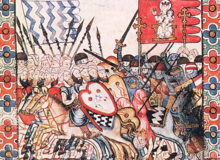
The
The Moorish

The Inquisition was aimed mostly at Jews and Muslims who had overtly converted to Christianity but were thought to be practicing their faiths secretly. They were respectively called
Some Muslims converted to Christianity and remained permanently in Iberia. This is indicated by a "high mean proportion of ancestry from North African (10.6%)" that "attests to a high level of religious conversion (whether voluntary or enforced), driven by historical episodes of social and religious intolerance, that ultimately led to the integration of descendants."[48][49] According to historian Richard A. Fletcher,[50] "the number of Arabs who settled in Iberia was very small. 'Moorish' Iberia does at least have the merit of reminding us that the bulk of the invaders and settlers were Moors, i.e., Berbers from Algeria and Morocco."
In the meantime, Spanish and Portuguese expeditions westward from the New World spread Christianity to India, the Malay Peninsula, Indonesia, and the Philippines. By 1521, the ships of Magellan had reached that island archipelago, which they named Las Islas Filipinas, after Philip II of Spain. In Mindanao, the Spaniards named the kris-bearing people as Moros or 'Moors'. Today this ethnic group in Mindanao, who are generally Filipino Muslim, are called "Moros".
Moors of Sicily

The first Muslim conquest of Sicily began in 827, though it was not until 902 that almost the entire island was in the control of the Aghlabids, with the exception of some minor strongholds in the rugged interior. During that period some parts of southern Italy fell under Muslim control, most notably the port city of Bari, which formed the Emirate of Bari from 847 to 871. In 909, the Aghlabids was replaced by the Isma'ili rulers of the Fatimid Caliphate.[citation needed] Four years later, the Fatimid governor was ousted from Palermo when the island declared its independence under Emir Ahmed ibn-Kohrob. The language spoken in Sicily under Muslim rule was Siculo-Arabic.
In 1038, a Byzantine army under George Maniakes crossed the strait of Messina. This army included a corps of Normans that saved the situation in the first clash against the Muslims from Messina. After another decisive victory in the summer of 1040, Maniaces halted his march to lay siege to Syracuse. Despite his success, Maniaces was removed from his position, and the subsequent Muslim counter-offensive reconquered all the cities captured by the Byzantines.
The Norman
The Muslim problem characterized Hohenstaufen rule in Sicily under Holy Roman Emperors Henry VI and his son, Frederick II. Many repressive measures were introduced by Frederick II to appease the popes, who were intolerant of Islam in the heart of Christendom. This resulted in a rebellion by Sicilian Muslims, which in turn triggered organized resistance and systematic reprisals and marked the final chapter of Islam in Sicily. The complete eviction of Muslims and the annihilation of Islam in Sicily was completed by the late 1240s when the final deportations to Lucera took place.[52]
The remaining population of Sicilian Muslims converted to Catholicism due to the incentives put in place by Fredrich II.[53] Some Muslims from Lucera would also later convert due to oppression on the mainland and had their property returned to them and returned to Sicily.
During the reigns of Frederick II as well as his son, Manfred, a large amount of Muslims were brought, as slaves, to farm lands and perform domestic labor. Enslaved persons in Sicily were not afforded the same privileges as the Muslims in mainland Italy.[54] The trend of importing a considerable amount of slaves from the Muslim world did not stop with the Hohenstaufen but was amplified under the Aragonese and Spanish crowns, and was in fact continued until as late as 1838[55][56][57] The majority of which would also come receive the label 'Moors'[58][59]
Architecture

In heraldry


Moors—or more frequently their heads, often crowned—appear with some frequency in medieval European
Armigers bearing moors or moors' heads may have adopted them for any of several reasons, to include symbolizing military victories in the Crusades, as a pun on the bearer's name in the canting arms of Morese, Negri, Saraceni, etc., or in the case of Frederick II, possibly to demonstrate the reach of his empire.[63] The arms of Pope Benedict XVI feature a moor's head, crowned and collared red, in reference to the arms of Freising, Germany.[64] In the case of Corsica and Sardinia, the blindfolded moors' heads in the four quarters have long been said to represent the four Moorish emirs who were defeated by Peter I of Aragon and Pamplona in the 11th century, the four moors' heads around a cross having been adopted to the arms of Aragon around 1281–1387, and Corsica and Sardinia having come under the dominion of the king of Aragon in 1297.[65] In Corsica, the blindfolds were lifted to the brow in the 18th century as a way of expressing the island's newfound independence.[66]
The use of Moors (and particularly their heads) as a heraldic symbol has been deprecated in modern North America.[67] For example, the College of Arms of the Society for Creative Anachronism urges applicants to use them delicately to avoid causing offence.[68]
In popular culture
- The title character in William Shakespeare's play Othello, and the derived title character in Verdi's opera Otello, is identified as a Moor. A lesser-known Moorish character, Aaron, appears in Shakespeare's earlier tragedy Titus Andronicus.
- The Second Spanish Republic Spanish Civil War song "¡Ay Carmela!" refers to the Moors fighting alongside Francisco Franco.
- Morgan Freeman's character Azeem in the 1991 film Robin Hood: Prince of Thieves, saved from prison by Robin Hood, is identified as a Moor.
Notable Moors
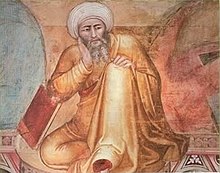
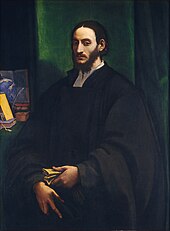
- conquered Hispaniain 711
- Umayyad Emirate of Córdoba in 756; along with its succeeding Caliphate of Córdoba, the dynasty ruled Islamic Iberiafor three centuries.
- Ibn al-Qūṭiyya, Andalusian historian and grammarian.
- Malikischool of jurisprudence in Al-Andalus.
- Abbas ibn Firnas, 810–887, Berber inventor, poet, and scientist in the Emirate of Córdoba.
- Maslama al-Majriti, died 1007, Andalusian writer believed to have been the author of the Encyclopedia of the Brethren of Purity and the Picatrix.
- Andalusian physician and surgeon whose work Al-Tasrif, published in 1000, remained influential for centuries.
- Said Al-Andalusi, 1029–1070, Andalusian Qadi, historian, philosopher, mathematician and astronomer.
- Tables of Toledo.
- Artephius, a writer to whom a number of alchemical texts are ascribed.
- Andalusian physicist and polymath whose theory of motion, including the concept of a reaction force, influenced the development of classical mechanics.
- parasites and pioneered experimentalsurgery.
- Moorish geographer and polymath who drew the Tabula Rogeriana, the most accurate world map in pre-modern times.
- philosophical novel.
- Averroes (Ibn Rushd), 1126–1198, classical Islamic philosopher and polymath who wrote The Incoherence of the Incoherence and several Aristotelian commentaries, and established the school of Averroism.
- Andalusian botanist and pharmacist who compiled the most extensive pharmacopoeiaand botanical compilation in pre-modern times.
- economics in the Muqaddimahin 1377.
- Moorish mathematician who helped popularize algebraic symbolism.
- Leo Africanus, 1494–1554, Andalusian geographer, author and diplomat, who was captured by Spanish pirates and sold as a slave, but later baptized and freed.
- Estevanico, also referred to as "Stephen the Moor", was an explorer in the service of Spain of what is now the southwest of the United States.
- Ibn Battuta, an Islamic scholar and Moorish explorer who is generally considered one of the greatest travellers of all time.
- Muslim World and is widely acknowledged as the father of Comparative religionstudies.
- Ibn Idhari, a Moorish historian who was the author of (Al-Bayan al-Mughrib) an important medieval text on the history of the Maghreb and Iberia.
- Ibn Arabi, Andalusian Sufi mystic and philosopher.
- Maliki law from al-Andalus.
See also
- Adarga
- Almoravid dynasty
- Blackamoor (decorative arts)
- Böszörmény
- Genetic history of the Iberian Peninsula
- Genetic studies on Moroccans
- History of North Africa
- History of Portugal
- History of Spain
- Islam in Spain
- Marinid dynasty
- Moorish Revival architecture
- Orientalism
- Ricote (Don Quixote)
- Timeline of the Muslim presence in the Iberian Peninsula
- Sicily
- Emirate of Sicily
- Farang
Notes
References
- ISBN 9789047441540– via Brill.com
- ^ Ross Brann, "The Moors?", Andalusia, New York University. Quote: "Andalusi Arabic sources, as opposed to later Mudéjar and Morisco sources in Aljamiado and medieval Spanish texts, neither refer to individuals as Moors nor recognize any such group, community or culture."
- ^ Chisholm, Hugh, ed. (1911). . Encyclopædia Britannica. Vol. 18 (11th ed.). Cambridge University Press. p. 812.
- ISBN 978-0-8166-4832-0.
- ISBN 0-316-16871-8, p. 241
- ISBN 9780192129543. Retrieved March 12, 2014.
In one sense the word 'Moor' means Mohammedan Berbers and Arabs of North-western Africa, with some Syrians, who conquered most of Spain in the 8th century and dominated the country for hundreds of years.
- ^ Pieris, P.E. Ceylon and the Hollanders 1658–1796. American Ceylon Mission Press, Tellippalai Ceylon 1918
- ^ "Assessment of the status, development and diversification of fisheries-dependent communities: Mazara del Vallo Case study report" (PDF). European Commission. 2010. p. 2. Retrieved 28 September 2012.
In the year 827, Mazara was occupied by the Arabs, who made the city an important commercial harbour. That period was probably the most prosperous in the history of Mazara.
- ISBN 0-472-11092-6.
- ISBN 978-1-135-19388-1.
- ISBN 978-90-04-09796-4.
- ^ Ditson, George Leighton (1860). Adventures and Observations on the North Coast of Africa, Or, The Crescent and French Crusaders. Derby & Jackson. p. 122.
- .
- ^ "Online Etymology Dictionary". Etymonline.com. Retrieved 2014-05-12.
- ^ οἰκοῦσι δ᾽ ἐνταῦθα Μαυρούσιοι μὲν ὑπὸ τῶν Ἑλλήνων λεγόμενοι, Μαῦροι δ᾽ ὑπὸ τῶν Ῥωμαίων καὶ τῶν ἐπιχωρίων "Here dwell a people called by the Greeks Maurusii, and by the Romans and the natives Mauri" Strabo, Geographica 17.3.2. Lewis and Short, Latin Dictionary, 1879 s.v. "Mauri"
- ^ Cornelius Tacitus, Arthur Murphy, The Historical Annals of Cornelius Tacitus: With Supplements, Volume 1 (D. Neall, 1829 ) p114.
- ^ Assouline, David. "'Moors' from Oxford Islamic Studies Online". Muslim Journeys. The Oxford Encyclopedia of the Islamic World in the Oxford Islamic Studies Online. Archived from the original on 20 May 2018. Retrieved 30 May 2018.
- ^ Africanus, Leo (1526). The History and Description of Africa. Hakluyt Society. pp. 20 & 108. Retrieved 30 August 2017.
the Mauri – or Moors – were the Berbers
- ISBN 0-415-28096-6
- ^ ASALE, RAE-. ""Diccionario de la lengua española" – Edición del Tricentenario". «Diccionario de la lengua española» – Edición del Tricentenario.
- ISBN 978-90-420-0260-9.
- ISBN 978-0-415-33939-1.
- ISBN 978-0-415-55649-1.
- ISBN 978-0-415-35515-5.
- ISBN 978-90-420-2538-7.
- ^ Lodovico Sforza, in: Thomas Gale, Encyclopedia of World Biography, 2005–2006
- ^ Xosé Manuel González Reboredo, Leyendas Gallegas de Tradición Oral (Galician Legends of the Oral Tradition), Galicia: Editorial Galaxia, 2004, p. 18, Googlebooks, accessed 12 Jul 2010 (in Spanish)
- ^ Rodney Gallop, Portugal: A Book of Folkways, Cambridge University Press (CUP), 1936; reprint CUP Archives, 1961, Googlebooks, accessed 12 Jul 2010.
- ^ Francisco Martins Sarmento, "A Mourama" Archived 2012-03-14 at the Wayback Machine, in Revista de Guimaraes, No. 100, 1990, Centro de Estudos de Património, Universidade do Minho, accessed 12 Jul 2010 (in Portuguese)
- ^ "Morris Student Plus". www1.euskadi.net. Archived from the original on November 4, 2014.
- ISBN 9780470672914.
- ^ Subrahmanyam, Sanjay."The Political Economy of Commerce: Southern India 1500-1650" Cambridge University Press, (2002)
- ^ "WWW Virtual Library: From where did the Moors come?". www.lankalibrary.com.
- ^ Rodd, Francis. "Kahena, Queen of the Berbers: "A Sketch of the Arab Invasion of Ifriqiya in the First Century of the Hijra" Bulletin of the School of Oriental Studies, University of London, Vol. 3, No. 4, (1925), 731–2
- ^ a b Lapidus, 200–201
- ^ "Sala de los Reyes", alhambradegranada.org
- ^ Board of the Alhambra, SALA DE LOS REYES
- ISBN 978-0-520-24840-3.
- ^ Blakemore, Erin (12 December 2019). "Who were the Moors?". National Geographic. Archived from the original on June 18, 2020. Retrieved 2020-10-30.
- ISBN 9780520248403.
- ISBN 978-9004095991.
- ^ Ibn Hazm, طوق الحمامة
- ISBN 9780520248403.
- ISBN 1-903809-81-9
- Jewish Encyclopedia. 1906 ed.
- ISBN 1-56131-022-0.
- ^ See History of Al-Andalus.
- ^ Adams et al., "The Genetic Legacy of Religious Diversity and Intolerance: Paternal Lineages of Christians, Jews, and Muslims in the Iberian Peninsula", Cell, 2008. Quote: "Admixture analysis based on binary and Y-STR haplotypes indicates a high mean proportion of ancestry from North African (10.6%) ranging from zero in Gascony to 21.7% in Northwest Castile."
- ^ Elena Bosch, "The religious conversions of Jews and Muslims have had a profound impact on the population of the Iberian Peninsula" Archived 2009-05-21 at the Wayback Machine, Universitat Pompeu Fabra, 2008, Quote: "The study shows that religious conversions and the subsequent marriages between people of different lineage had a relevant impact on modern populations both in Spain, especially in the Balearic Islands, and in Portugal."
- ISBN 978-0-520-08496-4
- ISBN 2-262-02297-6.
- ^ Abulafia, David (1988). Frederick II: A Medieval Emperor. London: Allen Lane.
- doi:10.1400/229481.
- S2CID 216117913.
- ISBN 978-3-030-01349-3.
- ^ De Lucia, Lori (2020). Sicily and the Two Seas: The Cross Currents of Race and Slavery in Early Modern Palermo (PhD dissertation). UCLA.
- ^ Goodman, Jack (June 2017). Slavery and Manumission in Fourteenth-Century Palermo (PhD dissertation). Western Michigan University.
- ISSN 0083-5897.
- ISSN 0951-8967.
- ^ Curl p. 502.
- ^ Pevsner, The Penguin Dictionary of Architecture.
- ^ Parker, James. "Man". A Glossary of Terms Used in Heraldry. Retrieved 2012-01-23.
- ^ a b c "Africans in medieval & Renaissance art: the Moor's head". Victoria and Albert Museum. 2011-01-13. Retrieved 2012-01-23.
- ^ Mons. Andrea Cordero Lanza di Montezemolo. "Coat of Arms of His Holiness Benedict XVI". The Holy See. Retrieved 2013-01-25.
- ^ Sache, Ivan (2009-06-14). "Corsica (France, Traditional province)". Flags of the World. Retrieved 2013-01-25.
- ^ Curry, Ian (2012-03-18). "Blindfolded Moors – The Flags of Corsica and Sardinia". Vaguely Interesting. Retrieved 2013-01-25.
- ^ In his July 15, 2005 blog article "Is that a Moor's head?", Mathew N. Schmalz refers to a discussion on the American Heraldry Society's website where at least one participant described the moor's head as a "potentially explosive image".
- ^ "Part IX: Offensive Armory". Rules for Submissions of the College of Arms of the Society for Creative Anachronism, Inc. 2008-04-02. Retrieved 2012-01-23.
- ^ Furtado, A. D. (1981). Goa, yesterday, to-day, tomorrow: an approach to various socio-economic and political issues in Goan life & re-interpretation of historical facts. Furtado's Enterprises. pp. 254 pages(page xviii).
Bibliography
- This section's bibliographical information is not fully provided. If you know these sources and can provide full information, you can help Wikipedia by completing it.
- Jan R. Carew. Rape of Paradise: Columbus and the birth of racism in America. Brooklyn, NY: A&B Books, c. 1994.
- David Brion Davis, "Slavery: White, Black, Muslim, Christian." New York Review of Books, vol. 48, #11 July 5, 2001. Do not have exact pages.
- Herodotus, The Histories
- Shomark O. Y. Keita, "Genetic Haplotypes in North Africa"
- Shomarka O. Y. Keita, "Studies of ancient crania from northern Africa." American Journal of Physical Anthropology 83:35–48 1990.
- Shomarka O. Y. Keita, "Further studies of crania from ancient northern Africa: an analysis of crania from First Dynasty Egyptian tombs, using multiple discriminant functions." American Journal of Physical Anthropology 87: 345–54, 1992.
- Shomarka O. Y. Keita, "Black Athena: race, Bernal and Snowden." Arethusa 26: 295–314, 1993.
- Bernard Lewis, "The Middle East".
- Bernard Lewis. The Muslim Discovery of Europe. NY: Norton, 1982. Also an article with the same title published in Bulletin of the School of Oriental and African Studies, University of London 20(1/3): 409–16, 1957.
- Bernard Lewis, "Race and Slavery in Islam".
- Stanley Lane-Poole, assisted by E. J. W. Gibb and Arthur Gilman. The Story of Turkey. NY: Putnam, 1888.
- Stanley Lane-Poole. The Story of the Barbary Corsairs. NY: Putnam,1890.
- Stanley Lane-Poole, The History of the Moors in Spain.
- J. A. (Joel Augustus) Rogers. Nature Knows No Color Line: research into the Negro ancestry in the white race. New York: 1952.
- Ronald Segal. Islam's Black Slaves: the other Black diaspora. NY: Farrar Straus Giroux, 2001.
- Frank Snowden. Before Color Prejudice: the ancient view of blacks. Cambridge, Massachusetts: Harvard Univ. Press, 1983.
- Frank Snowden. Blacks in antiquity: Ethiopians in the Greco-Roman experience. Cambridge, Massachusetts: Belknap Press of Harvard University Press, 1970.
- David M. Goldenberg. The Curse of Ham: race and slavery in early Judaism, Christianity, and Islam. Princeton, NJ: Princeton University Press, c2003.
- Lucotte and Mercier, various genetic studies
- Eva Borreguero. "The Moors Are Coming, the Moors Are Coming! Encounters with Muslims in Contemporary Spain." p. 417-32 in Islam and Christian-Muslim Relations, 2006, vol. 17, no. 4, pp. 417–32.
External links
- The "Moors" of West Africa and the Beginnings of the Portuguese Slave Trade Published from Pomona Faculty Publications and Research from Claremont Colleges
- 'Moors' from Oxford Islamic Studies Online
- "The Moors" by Ross Brann, published on New York University website.
- Secret Seal: On the image of the Blackamoor in European Heraldry, a PBS article.
- Encyclopedia – Britannica Online Encyclopedia (2006)
- Khalid Amine, Moroccan Shakespeare: From Moors to Moroccans. Paper presented at an International Conference Organized by The Postgraduate School of Critical Theory and Cultural Studies, University of Nottingham, and The British Council, Morocco, 12–14 April 2001.
- Africans in Medieval & Renaissance Art: The Moor's Head, Victoria and Albert Museum (n.d)
- Sean Cavazos-Kottke. Othello's Predecessors: Moors in Renaissance Popular Literature: (outline). Folger Shakespeare Library, 1998.
